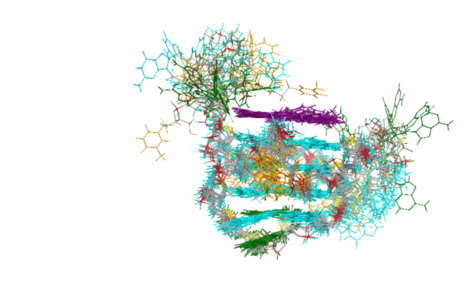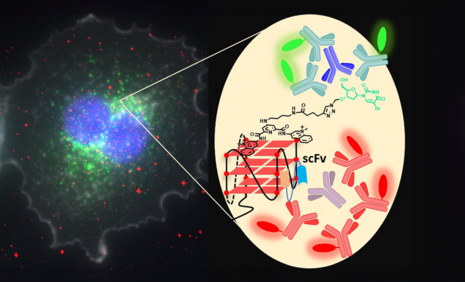Unité
Chimie et Modélisation pour la Biologie du Cancer (UMR9187 / U1196)
Axes de recherche thématiques :
Image

Retraite scientifique de l'UMR9187/U1196 au Domaine Saint-Paul à Saint-Rémy-lès-Chevreuse le 18 avril 2023
To top
Unité
FLORENCE MAHUTEAU-BETZER
Chimie et Modélisation pour la Biologie du Cancer (UMR9187 / U1196)
L’activité centrale de l’unité CMBC est de développer des petites molécules pour sonder et contrôler les activités biologiques de cibles impliquées dans le cancer. Ce sont des structures non canoniques d’acides nucléiques (G-quadruplexes, sites abasiques, …) et des protéines (Kinases TAM, acides nucléiques non B interagissant avec des protéines, …).
Les équipes
- Médicaments et sondes pour les structures secondaires des acides nucléiques
 MARIE-PAULE TEULADE-FICHOU
MARIE-PAULE TEULADE-FICHOU
Chiffres-clés
10
brevets déposés sur les 5 dernières années
1
molécule en phase clinique pour la rectocolite hémorragique (phase 3 prévue fin 2021)
Publications clés
Toutes les publications
-
Anti-Cancer and Radio-Sensitizing Properties of New Bimetallic (<i>N</i>-Heterocyclic Carbene)-Amine-Pt(II) ComplexesJournal of Medicinal Chemistry
-
-
ASC-G4, an algorithm to calculate advanced structural characteristics of G-quadruplexesNucleic Acids Research
-
Tyro3 Targeting as a Radiosensitizing Strategy in Bladder Cancer through Cell Cycle DysregulationInternational Journal of Molecular Sciences
-
Cytidine deaminase deficiency in tumor cells is associated with sensitivity to a naphthol derivative and a decrease in oncometabolite levelsCellular and Molecular Life Sciences
-
Acridine–O6-benzylguanine hybrids: Synthesis, DNA binding, MGMT inhibition and antiproliferative activityEuropean Journal of Medicinal Chemistry
-
-
Actualités
Toutes les actualités
-
 Une molécule issue de travaux menés à l’Institut Curie et développée par Abivax présente des résultats prometteurs pour son essai de phase 2aUne molécule née dans les laboratoires de l’Institut Curie, désormais dans les mains de la société Abivax, révèle des résultats très prometteurs pour son essai clinique de phase 2a. A la clé ? De nouvelles thérapies qui pourraient s’avérer révolutionnaires pour la prise en charge des patients atteints de polyarthrite rhumatoïde et plus largement de maladies inflammatoires chroniques, aujourd’hui difficiles à traiter.25/03/2022
Une molécule issue de travaux menés à l’Institut Curie et développée par Abivax présente des résultats prometteurs pour son essai de phase 2aUne molécule née dans les laboratoires de l’Institut Curie, désormais dans les mains de la société Abivax, révèle des résultats très prometteurs pour son essai clinique de phase 2a. A la clé ? De nouvelles thérapies qui pourraient s’avérer révolutionnaires pour la prise en charge des patients atteints de polyarthrite rhumatoïde et plus largement de maladies inflammatoires chroniques, aujourd’hui difficiles à traiter.25/03/2022 -
 Des collaboratrices de l’Institut Curie rendent hommage aux 110 ans du 2e prix Nobel de Marie CurieA l'occasion des 110 ans du 2e prix Nobel de Marie Curie le 10 décembre 2021 et le Jour J de la traditionnelle cérémonie de remise des prix à Stockholm, cinq chercheuses et médecins de l’Institut Curie ont répondu aux questions : « Que représente pour vous cette double distinction attribuée à la célèbre scientifique ? En quoi la figure de Marie Curie vous inspire-t-elle dans vos travaux et dans votre métier ? ».10/12/2021
Des collaboratrices de l’Institut Curie rendent hommage aux 110 ans du 2e prix Nobel de Marie CurieA l'occasion des 110 ans du 2e prix Nobel de Marie Curie le 10 décembre 2021 et le Jour J de la traditionnelle cérémonie de remise des prix à Stockholm, cinq chercheuses et médecins de l’Institut Curie ont répondu aux questions : « Que représente pour vous cette double distinction attribuée à la célèbre scientifique ? En quoi la figure de Marie Curie vous inspire-t-elle dans vos travaux et dans votre métier ? ».10/12/2021 -
 Abivax : son candidat médicament déclaré « priorité nationale de recherche » pour sa lutte contre la Covid-19Abivax, biotech issue de la collaboration entre l’Institut Curie et l’IGMM, a annoncé ce 22 décembre 2020, l’obtention du statut de "priorité nationale de recherche" pour l’essai clinique de son candidat médicament ABX464 visant à prévenir l'inflammation pour les patients atteints de la Covid-19, délivré par le gouvernement français.05/01/2021
Abivax : son candidat médicament déclaré « priorité nationale de recherche » pour sa lutte contre la Covid-19Abivax, biotech issue de la collaboration entre l’Institut Curie et l’IGMM, a annoncé ce 22 décembre 2020, l’obtention du statut de "priorité nationale de recherche" pour l’essai clinique de son candidat médicament ABX464 visant à prévenir l'inflammation pour les patients atteints de la Covid-19, délivré par le gouvernement français.05/01/2021
Événements scientifiques
Tous les événements scientifiques
28 mai
2024
Séminaire
14h-23h
Centre de recherche - Orsay - Amphithéâtre du Bâtiment 111
Molecular Imaging and Microphysiological Culture Systems towards Improved Radiotherapy Guidance
The presentation will focus on our recent and ongoing work in the fields of MRI-guided radiotherapy (and sentinel node biopsy) and on the development of microphysiological culture systems for radiobiological studies. In close collaboration with Ferronova, our team is developing a family of MRI contrast agent based on iron oxide nanoparticles. The first generation of the FerroTrace technology is ta
9 fév
2024
Séminaire
14h-23h
Centre de recherche - Orsay - Amphithéâtre du Bâtiment 111
Plant-derived chemical probes and leads that target OSBP protein, a key player in cholesterol homeostasis
Living organisms like plants, produce specialized metabolites to defend themselves against predators or pests. They can be viewed as privileged structures pre-validated by Nature and are invaluable starting points for drug discovery programs and probe synthesis. This seminar will focus on schweinfurthins and their derivatives, compounds with promising anti-cancer properties that target OSBP
8 déc
2023
Séminaire Orsay series
11h-23h
Centre de recherche - Orsay - Amphithéâtre du Bâtiment 111
Illuminating the Path: A ChemBio Toolbox for Biological Processes
Life is highly dynamic relaying on a myriad of carefully orchestrated processes with strict spatial and temporal control. To decipher cellular functions and, in turn, address complex biological questions is necessary to have precise control. In my group, we pursue such the dream of achieving a molecularly precise understanding of biology to address the problems arising from misregulation. For this
26 juin
2023
Séminaire
12h-12h
Centre de recherche - Orsay - Amphithéâtre du Bâtiment 111
Chemical Biology Tools to unravel biological functions of nucleic acids secondary structures
DNA and RNA containing runs of 3 or 4 adjacent guanines may spontaneously arrange into four-stranded DNA supramolecular structures called G-quadruplexes (G4). These non-canonical structures are likely to form in G-rich regions throughout the genome and thus are assumed to have functional roles in key biological processes, such as replication, transcription, repair, and recombination, and thereby t
26 juin
2023
Séminaire
11h-12h
Centre de recherche - Orsay - Amphithéâtre du Bâtiment 111
Proximity-induced targeted RNA degradation for mapping RNA modifications and drugging SARS-CoV-2 genome
Using small molecules to modulate RNA stability is an emerging paradigm which holds promise to greatly expand the space of druggable biomolecules. In this talk I will present two divergent applications of small molecule-induced targeted RNA degradation. Firstly, we devised a click chemistry- and degradation-based method to map RNA modifications, meCLICK-Seq. This unorthodox approach enabled discov









